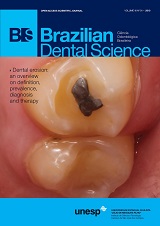Influence of dentin abrasion methods on the bond strength of self-etching adhesive systems
DOI:
https://doi.org/10.14295/bds.2013.v16i1.852Abstract
The aim of this study was to compare the bond strength of two self-etching adhesive systems with different types of dentin abrasion. Thirty two sound human molars were selected and had the dentin surface exposed and flattened. Tooth were randomly divided into four experimental conditions, according with the adhesive system [Clearfil SE Bond (SE) and One- Up Bond F(ONE)] and the type of dentin abrasion [conventional diamond bur (D) and ultrasound
diamond bur (CVD)]. The adhesives were applied following manufactures’ instructions and light cured composite blocks of 4mm height were placed over dentin. After storage in distilled water for 24 h in 37 ºC, serial cuts were made on mesio-distal and buccal-lingual direction, obtaining specimens with stick format, with cross section of 8mm². The microtensile test was performed at a crosshead speed of 0.5 mm/min and load cell of 10kg, until failure. Data were submitted to ANOVA-2-Way followed by Tukey test (5%). The results (MPa) were: D/SE:24.06±8.84, D/ONE:15.03±8.61, CVD/SE:39.90±8.24 and CVD/ONE:15.03±8.61. It can be concluded that the adhesive system Clearfil SE Bond showed higher bond strength
related with the abrasion with CVD; the type of dentin abrasion interfered on the performance of Clearfil SE Bond but did not influence the One-Up Bond F results.
KEYWORDS
Self-etching adhesive systems, Microtensile, Bond
strength, Dentin.
Downloads
Downloads
Published
How to Cite
Issue
Section
License
Brazilian Dental Science uses the Creative Commons (CC-BY 4.0) license, thus preserving the integrity of articles in an open access environment. The journal allows the author to retain publishing rights without restrictions.
=================




























